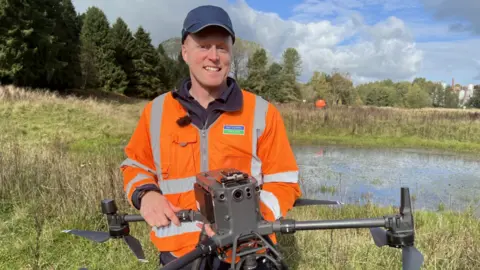Water company using drones to spot leaks 'faster'
 BBC
BBCA water company says using drones to spot leaks and flooding damages from the sky has saved it "potentially hundreds of thousands" of pounds per year.
Severn Trent bosses said the technology can detect leaks "earlier", which means workers can "rapidly determine what extra resources are needed onsite".
Drones are fitted with thermal imaging, which can detect dips in temperature on land, indicating a below-ground water leak.
Drone lead Duncan Turner said: "If we can find these leaks faster and deal with them quicker, that make things better for customers.”
He added: "The offset costs of just using drones instead of scaffolding to look at one of our digesters, for instance, creates enormous time and cost savings."
Severn Trent has committed to reducing leakage by 15% by 2025 and is aiming to halve the amount of water lost through its network by 2045.

Drone safety officer Jonny Bevan said: "Trying to identify a leak on a pipeline that is say 6km (3.7 miles) long may have taken some time for our teams on the ground to find before.
"But we can reduce that to a few hours with the drones."
The drones – including models called Flyability Elios, Matrice 300 and Inspire 2 - have been used at most Severn Trent sites.
'Promising area'
Dr Omid Maghazei, a lecturer at the University of Bath, is researching "where, why and how" to use drones in operational settings.
He told the BBC there are many "promising areas" for drones in business, with Amazon trialling using drones for deliveries.
He said: "This concerns agriculture, inspection of critical infrastructure - bridges, wind-turbines, powerplants, pipe lines of many process industries.
"Accessing areas that are not always easy - drones are cheaper and quicker."
Follow BBC Gloucestershire on Facebook, X and Instagram. Send your story ideas to us on email or via WhatsApp on 0800 313 4630.
